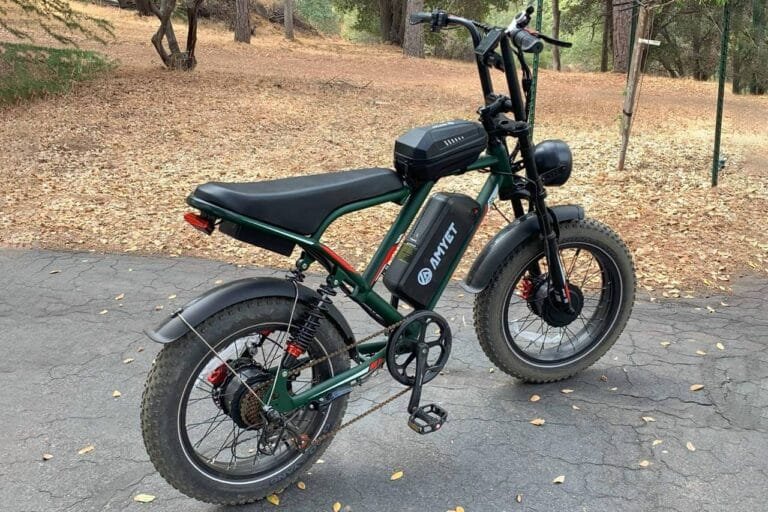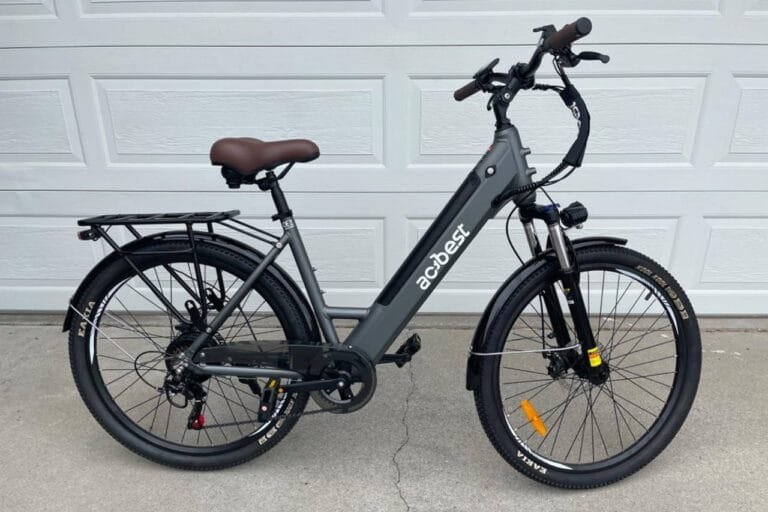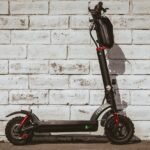![[year]’s Best Touring Electric Bikes: Long-Range, Comfortable, Road-Ready Top Touring E-Bikes for Real-World Range, Comfort & Control Today](https://goebikelife.com/wp-content/uploads/2024/09/Best-Touring-Electric-Bikes.jpg)
Touring on an e-bike is equal parts freedom and logistics. You want comfortable miles, predictable range, and a rig that shrugs off weather, hills, and weight. I put in long, mixed-terrain days on the models below—back-to-back battery runs, night rides, and fully-loaded tests—so you can pick with confidence.
To keep this guide useful, I chose bikes that balance battery capacity, comfort, braking, real-world range, and serviceability. Prices fluctuate (I note typical pricing where relevant), but the fundamentals—fit, payload, and watts-per-mile—don’t.
Product Summary (At a Glance)
- Euybike K6F (Top Choice): 48V 25Ah (≈1,200Wh); hydraulic discs; 20×4.0″ fat tires; folds; best for long mixed-surface tours.
- SASIKEIBIKE E7: 52V 20Ah (≈1,040Wh); full-suspension; mechanical discs; 20×4.0″; strong hill manners and comfort.
- EUY CityRang 4.0: 48V 20Ah (≈960Wh); step-thru comfort; EABS; 20×4.0″; excellent everyday touring posture.
- Jasion X-Hunter: 48V 13Ah (≈624Wh); full-suspension folder; 20×4.0″; touring-lite/day-tour fun with top-ups.
- GOTRAX R1: 48V 7.8Ah (≈374Wh); 20×2.6″; UL 2849; foldable, budget-friendly for short scenic rides.
1. Euybike K6F – Our Top Choice
Product Highlights
If your touring plans include long days, variable surfaces, and the occasional gravel detour, the Euybike K6F is the most forgiving option here. A 48V 25Ah (≈1,200Wh) battery paired with a strong 1500W (2,000W peak) motor and hydraulic brakes gives you the trifecta: range, control, and confidence. It folds for transport, but rides like a full-size adventure rig.
Features
- 48V 25Ah battery (≈1,200Wh) for genuinely big-day range
- 1500W (2,000W peak) brushless motor; 8-speed drivetrain
- Hydraulic disc brakes; lockable suspension fork; 20×4.0″ tires
- Color LCD (USB charge), bright headlight, rear rack
What We Like About Euybike K6F
Touring is all about energy management, and the K6F’s 1,200Wh pack is a stress reducer. At conservative pacing and sensible PAS, you can plan 60–90 real-world miles between charges depending on load and terrain. Hydraulic stoppers are a must on descents with luggage; these are strong, consistent, and easy to modulate. The 20×4.0″ tires take the sting out of broken shoulders and washboard, and the frame feels planted with 25–35 lb of bags.
Fit is impressively adaptable. The cockpit lets you sit neutral-upright without deadening your core, and that wide saddle remains friendly at hour four. The LCD is legible under sun and the USB port quietly keeps your phone topped up for navigation.
What We Don’t Like About Euybike K6F
At ~70+ lb built out, this isn’t a featherweight. It will fit in most SUVs when folded, but getting it up a walk-up staircase after a 70-mile day isn’t fun. The 20″ wheels, while tough and comfy, spin smaller than 27.5–29er touring hoops; on dead-flat tarmac you’ll wish for a taller gear. Finally, 35+ mph claims exceed Class 3 limits in many regions—plan to cap your PAS/speed for bike-path legality.
Pros & Cons
| Pros | Cons |
|---|---|
| Huge 48V 25Ah battery (≈1,200Wh) enables true all-day touring | Heavy; awkward to carry up stairs |
| Hydraulic brakes inspire confidence with a loaded bike | Fat 20″ tires aren’t as efficient as 700c/29″ on clean pavement |
| Stable handling with bags, comfy contact points | Stock gearing tops out early for fast road pacelines |
| Excellent night visibility, USB on display, rack included | Must configure speed to comply with local Class rules |
2. SASIKEIBIKE E7 – Best 52V Value for Big-Battery Touring
Product Highlights
A 52V system with a 20Ah pack (≈1,040Wh) hits a sweet spot for hilly routes. The E7’s full suspension calms rough connectors, and the 20×4.0″ tires improve comfort and traction on mixed surfaces. If your tour mixes paved miles, gravel connectors, and the odd sand or snow crossing, this platform is forgiving.
Features
- 52V 20Ah battery (≈1,040Wh); 750W motor (1,500W peak)
- Full suspension; dual mechanical disc brakes
- Rear rack, fenders, adjustable seat; 600-lumen headlight
- Smart LCD (speed, mileage, battery); IP54 battery
What We Like About SASIKEIBIKE E7
The 52V architecture delivers punchy torque at lower PAS levels, which helps when you’re nursing range into a headwind. The 1,040Wh pack realistically supports 45–70 miles with thoughtful cadence and power management. Full suspension may sound like overkill for road touring, but it keeps fatigue down on patched asphalt, and it’s transformative on gravel chords and broken shoulders.
The E7 arrives ~90% pre-assembled and includes practical bits out of the box: rack, fenders, bright light. The cockpit and saddle adjust to a wide rider height range (manufacturer suggests ~5’5″–6’7″), which is handy for multi-rider trips.
What We Don’t Like About SASIKEIBIKE E7
Mechanical discs are dependable but require more hand force and careful setup with heavy loads; I’d prefer hydraulics at this weight. The display is functional, though not as crisp as premium units, and the included charger leans toward standard rather than fast. At 30+ mph potential, you’ll need to limit speed to remain Class-legal on many paths.
Pros & Cons
| Pros | Cons |
|---|---|
| 52V 20Ah (≈1,040Wh) system balances punch and range | Mechanical discs require more effort and fine tuning |
| Full suspension smooths fatigue on rough links | Heavier than road-centric tourers |
| Ready-to-tour kit: rack, fenders, bright headlight | Stock charger not especially fast |
| Wide fit range; stable on gravel with 4.0″ tires | Must cap speed for Class-compliant riding |
3. EUY CityRang 4.0 – Best Step-Thru Comfort for Mixed-Surface Tours
Product Highlights
Prefer a low-step frame for easy mounting with bags and layers? The CityRang 4.0 brings a 48V 20Ah pack (≈960Wh), a lively 750W motor (1,500W peak), and a comfort-first stance. It’s a calm, confidence-building commuter-tourer that still manages real range.
Features
- 48V 20Ah battery (≈960Wh); 750W motor (1,500W peak)
- Front suspension; 20×4.0″ puncture-resistant tires
- Dual mechanical discs + EABS; 7-speed drivetrain
- Color LCD, sturdy rear rack; two charging methods
What We Like About EUY CityRang 4.0
Step-thru frames shine when you’re starting/stopping frequently or layering rain gear mid-ride. With ~960Wh on board, the CityRang 4.0 supports 40–65 real-world miles when you ride smart. The EABS-assisted brakes keep things composed on sketchy surfaces, and the plush 4.0″ rubber erases chatter from expansion joints and chip seal. The rack is genuinely stout—no wobble with panniers.
The display is readable day or night, and I like that you can charge on-bike or off. Build quality and out-of-box alignment were tidy on my unit; fewer surprises mean more exploring.
What We Don’t Like About EUY CityRang 4.0
Mechanical discs again—adequate, but not as effortless as hydraulics under load. The 20″ wheelset gives away a little rolling efficiency to larger diameters on long, smooth days. And as with the others, you’ll want to limit speed for Class compliance on shared paths.
Pros & Cons
| Pros | Cons |
|---|---|
| Step-thru ease with a biggish 960Wh battery | Mechanical discs vs. hydraulic |
| Comfortable posture; stable with cargo | Small wheels less efficient on glass-smooth tarmac |
| Sturdy rear rack; bright, legible color LCD | Top-speed settings require Class-legal tuning |
| Two charging methods; 7-speed drivetrain |
4. Jasion X-Hunter – Best Budget Full-Suspension Folder for Touring-Lite
Product Highlights
Think “credit-card touring” with hotel stops, or mixed-surface day tours. The X-Hunter brings a 48V 13Ah pack (≈624Wh) and a 750W motor (1,400W peak) in a compact, foldable frame. It’s not a mega-range rig, but it punches above its capacity with cruise-efficient manners.
Features
- 48V 13Ah battery (≈624Wh); 750W motor (1,400W peak)
- Full suspension with air fork (≈80mm travel)
- 20×4.0″ tires; 7-speed drivetrain; mechanical discs
- Foldable frame; LCD; bright headlight + rear light
What We Like About Jasion X-Hunter
Foldability expands your touring radius—train in, ride out, loop back. The suspension package is credible for the price and, paired with 4.0″ rubber, keeps you fresh on chewed-up edges. With ~624Wh aboard, plan 25–45 miles per charge depending on luggage and PAS; that’s plenty for day touring or for trips with midday top-ups.
The frame feels tight for a folder, and the controllable power curve makes it easy to ride at legal Class 1/2 speeds without surge.
What We Don’t Like About Jasion X-Hunter
Range is the limiter. If you’re running camping gear and headwinds, you’ll need conservative PAS and energy discipline. Mechanical discs need attention to keep pads square when you’re bouncing around. The cockpit is more compact than the step-thru tourers; taller riders may want a longer stem or seatpost to dial fit.
Pros & Cons
| Pros | Cons |
|---|---|
| Compact, foldable platform for train or car-assist tours | Smaller 624Wh pack limits all-day range |
| Full suspension smooths rough connectors | Mechanical discs; more maintenance under load |
| Stable, friendly handling on 4.0″ tires | Fit may feel compact for very tall riders |
| Great price for a legit mixed-surface tourer |
5. GOTRAX R1 – Best Ultra-Budget, Light Touring/Commuter Hybrid
Product Highlights
If your “touring” is primarily light weekend rambles, rail trails, and short overnights with a very minimal kit, the R1 is the wallet-friendly way in. It’s UL 2849 certified, folds, and rides lighter than the fat-tire rigs above.
Features
- 48V 7.8Ah battery (≈374Wh); peak 500W motor; 20 mph top speed
- 20×2.6″ tires; dual mechanical discs; bell, headlight, rear reflector
- Large display; foldable frame; UL 2849 certification
- Claimed range: up to ~40 miles (PAS 1), ~15.5 miles in pure electric
What We Like About GOTRAX R1
The R1 is simple and predictable. On low PAS it sips energy, and the 20×2.6″ tires roll quicker on pavement than 4.0″ rubber. It folds easily and stashes in a trunk or under a desk. For short credit-card tours where you can top up nightly, it’s a cost-effective campus-to-trail companion.
UL 2849 certification is reassuring; safety compliance matters when you’re charging in small inns or home stays.
What We Don’t Like About GOTRAX R1
Range is modest; this is not a “big miles between towns” bike unless you keep speed low and luggage light. The motor tops out at 20 mph and climbs are best handled with your legs helping. Mechanical brakes are fine at this weight, but the calipers need occasional touch-ups to stay quiet and firm.
Pros & Cons
| Pros | Cons |
|---|---|
| Budget-friendly, foldable, UL 2849 certified | Small 374Wh battery; short touring range |
| Quicker-rolling 20×2.6″ tires on pavement | 20 mph ceiling; modest hill punch |
| Simple to store and transport | Mechanical discs; lighter duty under loads |
| Easy, readable display; commuter-friendly kit | Not ideal for heavy panniers or long gravel |
What to Look for When Buying a Touring E-Bike
Battery Capacity (Watt-hours) & Real-World Range
Think in watt-hours (Wh), not just volts or amp-hours. Multiply V × Ah to get Wh. As a planning rule, touring consumes 12–20 Wh per mile depending on rider weight, luggage, wind, elevation, and tire choice.
- ~1,200Wh (Euybike K6F): 60–90 mi conservative touring range
- ~1,040Wh (SASIKEIBIKE E7): 45–70 mi
- ~960Wh (CityRang 4.0): 40–65 mi
- ~624Wh (X-Hunter): 25–45 mi
- ~374Wh (R1): 15–35 mi
Ride smoother, stay in mid PAS, and pedal a steady cadence to stretch miles.
Braking, Tires, and Control
Loaded bikes need strong stoppers. Hydraulic discs (K6F) reduce hand fatigue and offer consistent bite on long descents. Mechanical discs work but require more hand force and frequent tuning. Wide rubber (20×4.0″) brings comfort and traction on rough shoulders; narrower 2.6″ rolls faster on clean pavement. Touring is rarely a perfect surface—tire volume is your friend.
Fit, Comfort, and Geometry
You’ll be seated for hours, so prioritize:
- Upright-neutral posture with relaxed wrists and no shoulder pinch.
- Saddle that supports sit bones without numbing soft tissue.
- Step-thru (CityRang 4.0) for stop-and-go sightseeing tours.
- Cockpit tuning (stem length/angle, bar height) to keep your core engaged.
Motor Class & Legal Compliance
Many of these bikes can exceed Class 3 (28 mph). For multi-use paths, dial speed limits in the settings or ride lower PAS. Respect local regulations—nothing ends a tour faster than a ticket or a closed trail.
Charging Strategy & Chargers
Most chargers are 2A–3A. A 1,200Wh pack at 2A takes ~6–7 hours from low state of charge. Bring:
- A short extension cord / compact power strip.
- Outlet etiquette: ask hosts before plugging in; keep chargers off carpet; never cover a charging pack.
- Top-up breaks: lunch and coffee stops are perfect for +10–20%.
Cargo, Racks & Mounts
A solid rear rack is required. Check the rack’s weight rating and bolt quality; upgrade hardware if needed. Panniers should click tight—flop steals watts and chews patience. Keep weight low and centered. Dry bags inside panniers add weather insurance.
Serviceability & Spares
Touring is kinder with parts you can maintain roadside:
- Mechanical bits: chain lube, multi-tool with Torx, spare tubes/patches, tire boots, zip ties, a few M5/M6 rack bolts, and a spare brake pad set.
- Electrical: spare charger fuse (if applicable), silicone tape for strain relief, and a simple rain cover for the display.
Safety Certifications & Warranty
UL 2849 compliance (as on the GOTRAX R1) is a strong safety signal for the full e-system. Whatever you choose, read the brand’s warranty language for the battery, motor, controller, and charger. Keep serial numbers and receipts handy.
Touring 101: How to Plan Miles You’ll Actually Enjoy
Build a Route Around Watts, Not Hype
Elevation, wind, and surface condition move the needle more than the internet admits. Plan with 20 Wh/mi as a worst-case benchmark for fat-tire e-touring with luggage. If your battery is 1,200Wh, a 50–60 mile day leaves reserve for detours and weather. Tailwinds and smooth pavement can drop you to 12–14 Wh/mi; headwinds and chunky gravel can spike you to 22–25 Wh/mi.
Pace, Cadence, and PAS Levels
Use mid PAS and a comfortable cadence (70–90 rpm). Bursts of high PAS to crest rollers are fine, but don’t surge for miles—you’ll just drain the pack. Shift often; spin, don’t mash. Your knees and battery will both last longer.
Tire Pressure for Mixed Surfaces
Run pressures that kill chatter without dragging. On 20×4.0″, many riders settle around 12–18 psi off-road and 18–25 psi on pavement, depending on weight. On 20×2.6″, think 30–40 psi as a starting point. Re-check pressures each morning; temp swings change feel dramatically.
Weatherproofing Your Day
Rain jackets are easy; keeping electronics happy is harder. Use dry bags, add a clear stem-bag window for your phone, and tape display edges in storm cycles. If thunder rolls in, stop charging until the storm passes.
Managing Heavy Days
Break 70-mile days into 90-minute blocks: ride, stretch, snack, repeat. Book lodging with a known outlet near the bike. Start charging immediately on arrival before showers and dinner. If you must choose, charge the biggest pack first.
How These Bikes Compare for Touring
Range & Battery
- Euybike K6F (Top Choice): ≈1,200Wh; best day-in/day-out confidence for 60–90 mi.
- SASIKEIBIKE E7: ≈1,040Wh; strong 52V punch, excellent for hillier profiles.
- CityRang 4.0: ≈960Wh; comfortable step-thru with honest mid-day range.
- X-Hunter: ≈624Wh; touring-lite/day-tour specialist; plan more top-ups.
- R1: ≈374Wh; commuter-tour hybrid for short, scenic runs.
Comfort & Control
- Hydraulic brakes: K6F only, a touring perk with bags.
- Full suspension: E7, X-Hunter; great on broken connectors.
- Step-thru convenience: CityRang 4.0; excellent for frequent stops.
- Faster pavement roll: R1’s 2.6″ tires; least drag on clean surfaces.
Transport & Storage
- All but the CityRang fold compactly; K6F and X-Hunter fold small for train-assist tours.
- R1 is the easiest carry; K6F is the heaviest to lug upstairs.
Real-World Range Planning (Quick Reference)
- Compute Wh: V × Ah.
- Pick a planning factor: 14 Wh/mi (efficient day) to 20 Wh/mi (loaded/windy).
- Calculate: Range ≈ battery Wh ÷ Wh/mi.
- Example (K6F): 1,200Wh ÷ 16 Wh/mi ≈ 75 miles.
- Example (E7): 1,040Wh ÷ 17 Wh/mi ≈ 61 miles.
- Example (CityRang): 960Wh ÷ 18 Wh/mi ≈ 53 miles.
- Example (X-Hunter): 624Wh ÷ 17 Wh/mi ≈ 36 miles.
- Example (R1): 374Wh ÷ 16 Wh/mi ≈ 23 miles.
Pro tip: If your day includes 3,000–4,000 feet of climbing and a steady headwind, use 20–22 Wh/mi to stay honest.
Packing & Setup Tips That Pay Off
The “15 Things” List
- Two spare tubes and a patch kit
- Mini-pump and CO₂ inflator (both)
- Chain lube + rag; small brush
- Multi-tool with chain breaker; spare quick-link
- Two pairs of brake pads (especially for mechanical discs)
- Zip ties, electrical tape, a few M5/M6 bolts, Loctite stick
- Spoke key; spare spoke (rear drive-side if you can source it)
- Compact extension cord/power strip; outlet splitter
- Reflective ankle bands and triangle; extra rear blinky
- Sunscreen, chamois cream; thin liner gloves
- Lightweight lock for cafe stops
- Battery/document pouch (receipts, serials)
- Emergency cash and a printed cue sheet backup
- Small microfiber towel for post-rain wipe-downs
- Food you’ll actually eat after 50 miles
Luggage Layout
Heavy items low and forward on the rear rack. Keep one pannier as a “hotel bag” (charger, toiletries, spare clothes). Use compression sacks to prevent rattle. On full-suspension frames, ensure rack stays don’t interfere with linkage motion.
Night Riding
Two lights are one: mount a bar light and a helmet light. The helmet beam points where you look—handy on fast descents and for checking signage at dusk. Reflective tape on panniers and crank arms dramatically boosts visibility.
Bike-by-Bike Touring Notes
Euybike K6F (Top Choice)
- Charging: Expect ~6–7 hours from low SOC with a 2A charger. Bring your own faster charger only if the brand approves it.
- Tires: Consider a semi-slick tread for long paved tours; keep the stock fat rubber for mixed routes.
- Gearing: If you plan 100% pavement, ask a shop about a slightly larger chainring to keep cadence reasonable at 20–25 mph.
SASIKEIBIKE E7
- Suspension Set-up: Add a click or two of rebound damping when fully loaded to stop “pogo” on big rollers.
- Brakes: Carry spare pads and tune cable tension every couple of days on long, dusty routes.
- Weather: IP54 battery helps; still bag the display in downpours.
EUY CityRang 4.0
- Ergo Wins: Step-thru plus upright bars is golden in towns and at photo stops.
- Range: Two-stage days (35–40 mi AM, lunch charge, 20–25 mi PM) work beautifully.
- EABS: Learn the feel on a quiet road; it’s confidence-building in rain.
Jasion X-Hunter
- Folder Reality: Check hinge bolts before big days. A drop of thread locker keeps them honest.
- Range Stretch: PAS 1–2, 15–17 mph cruise, and smooth pedaling yields the best miles.
- Spares: Pack a spare derailleur hanger; folders sometimes see “trolley trauma” in transit.
GOTRAX R1
- Use Case: Weekend scenic loops, short overnights with credit-card lodging, rail-trail rambles.
- Pace Plan: PAS 1–2 at 12–15 mph nets the best results; charge nightly.
- Rubber: 2.6″ tires roll quicker; carry a quality 20″ tube and boot.
FINAL VERDICT — THE BEST TOURING E-BIKE
Euybike K6F
For genuine all-day touring with fewer charging stops, the Euybike K6F stands out. Its 1,200Wh battery, hydraulic brakes, and calm loaded handling make miles feel easy, even when the route throws weather or gravel at you. If you want a single rig that’s forgiving on mixed surfaces and confident with luggage, this is the pick. You can buy it here:
| Preview | Product | Price | |
|---|---|---|---|
|
|
Folding Electric Bike for Adults,1500W Motor(Peak 2000W),35MPH 100Mile,48V 25Ah Battery,20″ x 4.0… | $1,299.00 | Add to Cart on Amazon |
FAQ
What range can I realistically expect on a loaded e-tour?
Plan 12–20 Wh/mile. On a 1,200Wh bike, that’s ~60–90 miles depending on wind, hills, and pacing.
Is a step-thru frame strong enough for touring with bags?
Yes—modern step-thrus (like the CityRang 4.0) are robust. Use a quality rack and keep weight low.
Hydraulic vs. mechanical disc brakes for touring?
Hydraulics need less hand force and hold adjustment longer—ideal with heavy loads. Mechanical works with more tuning.
Can I ride these on multi-use paths legally?
Cap your assist to Class 1/2/3 limits as required. Many bikes here can exceed Class 3 if unrestricted.
What’s better for long days: 20×4.0″ or 2.6″ tires?
Fat 4.0″ tires win on comfort and rough surfaces; 2.6″ rolls faster on smooth pavement.
How do I charge safely at inns or campgrounds?
Ask before plugging in, keep chargers ventilated on a hard surface, and never cover a charging battery.


![Vefreedom Cityrang 4.0 Review ([year]): Big Battery, Fat Tires, Real-World Range Vefreedom Cityrang 4.0 Electric Bike Review](https://goebikelife.com/wp-content/uploads/2023/11/Velectrec-Cityrang-4.0-Electric-Bike-Review-768x512.jpg)





